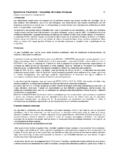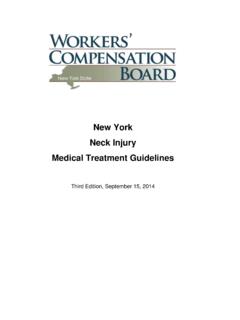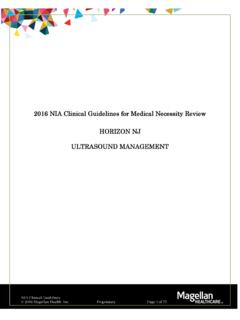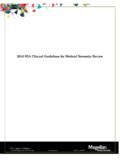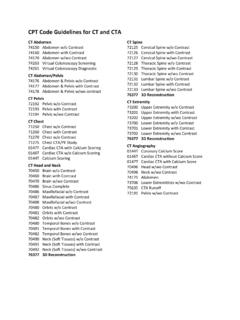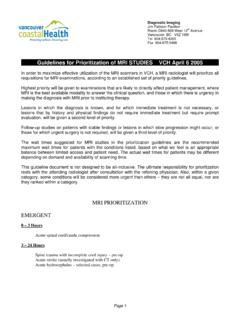Transcription of IMAGING GUIDELINES FOR THE CERVICAL SPINE
1 IMAGING GUIDELINES FOR THE. CERVICAL SPINE . FROM: Diagnostic IMAGING Practice GUIDELINES for Musculoskeletal Complaints in Adults An Evidence-Based Approach Part 3: Spinal Disorders. JMPT 2008. Jan; 31(1):33-88 Review. By: Andr Bussi res, DC, (PhD Cand). John Taylor DC, DACBR, Cynthia Peterson RN, DC, DACBR, GUIDELINES are not absolute RULES. TRAUMATIC (Acute) NON-TRAUMATIC. Apply Canadian C- Apply Red flags SPINE Rules Use Clinical judgment Use Clinical judgment Conventional radiographs are unlikely to show clinically significant injuries when all Canadian CERVICAL SPINE Rule criteria are fulfilled.. Canadian CERVICAL SPINE Rules Dangerous Mechanism of Injury Fall > 1 meter/5 stairs Axial cranial force (such as diving).
2 Road accident > 100 km/hr, ejected from vehicle or rollover Motorized recreational vehicle (ATT, snowmobile, etc). Must do 3 views: AP lower CERVICAL , AP. open mouth upper CERVICAL , neutral lateral CERVICAL . DO NOT DO. FLEXION/EXTENSION. Young adult male presented to Dutch DC after a fall from the roof. These hospital films were read as normal. After 3 view series CT is best for evaluating fractures. MRI is best for neurological deficits. CT is primary investigation for high risk patients on an emergency basis. Non-significant injuries may rarely be missed when the CCSR is properly applied . Spinous process fracture Transverse process fracture However, these are significant for manual therapy.
3 Thus apply Clinical Decision making. Adult male with acute onset of neck pain after MVA. Immediate post-trauma Immediate post-adjustment Adult Patient with Acute Uncomplicated Neck Pain (< 4 wks duration). Uncomplicated = non- Radiographs not traumatic neck pain routinely indicated without underlying Special Investigations neurologic deficits or not indicated red flags Adult pt. with non-traumatic neck pain and radicular symptoms Suspected acute Radiographs CERVICAL disc indicated herniation AP lower CERVICAL Suspected acute AP open mouth CERVICAL spondylotic Lateral radicular (rarely obliques). syndrome/lateral canal stenosis (Rare tumours causing neuro compression).
4 Adult pt. with uncomplicated subacute neck pain (4-12 wks' duration) with or without arm pain as well as pts with persistent neck pain (>12 wks) with or without arm pain Radiographs not initially indicated (Bone and Joint Decade 2000-2010 task force on neck pain and its associated disorders). If done: AP lower CERVICAL AP open mouth Lateral Adult pt. re-evaluation in the absence of expected treatment response or worsening after 4 wks Radiographs indicated AP lower CERVICAL AP open mouth Lateral Co-management or specialist referral or MRI recommended even if conventional radiographs are unremarkable. Adult patient with Red Flags'.
5 Pt < age 20 or > age 50 (65), Radiographs indicated particularly with S/S 3 view minimal series suggesting systemic disease May need referral for MRI or No response to care after 4 CT. weeks Significant activity restriction >. 4 wks Non-mechanical pain (unrelenting pain at rest, constant or progressive S&S. Neck rigidity in the sagittal plane in the absence of trauma Dysphasia Impaired consciousness Red Flags continued CNS S&S (cranial nerves, path Radiographs indicated reflexes, long tract signs) 3 view minimal series High risk ligamentous laxity Flexion lateral view added populations Check ADI. Arm or leg pain with neck Radiographs indicated movement 3 view minimal series Suspected CERVICAL myelopathy and radiculomyelopathy Suspected neoplasia Suspected infection Positive laboratory examination and + S&S.)
6 Sudden onset of acute and Immediate referral without unusual neck pain and/or plain films for advanced headache with or without IMAGING . neurological symptoms 56 year old female presented to her English chiropractor in 1999 with insidious onset of neck pain. It has not been relieved by Physiotherapy. There are no associated Symptoms H/O Breast cancer in 1984. Negative Radiographs do not necessarily clear' the patient when certain Red Flags are present History of Malignancy is one of these situations Middle-aged female presented to her DC in Wales with recent onset of headaches and dizziness. Thank you for your attentio

